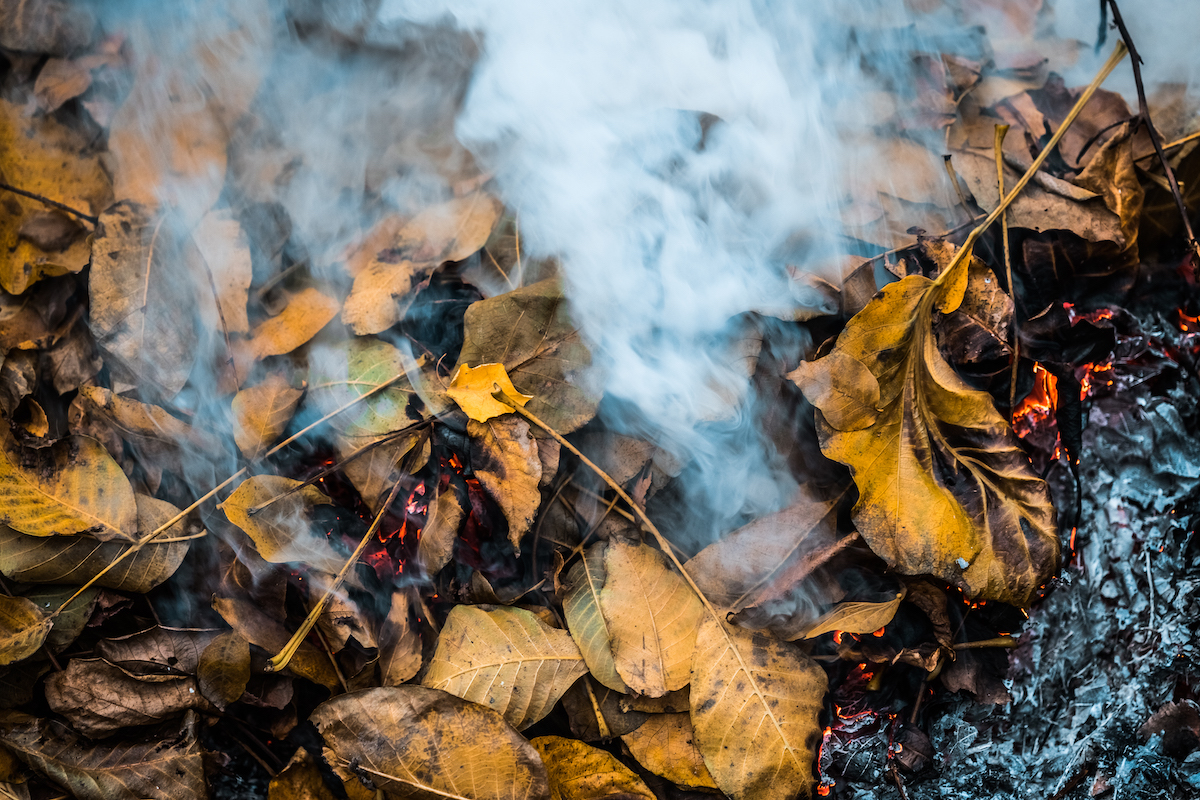

We may earn revenue from the products available on this page and participate in affiliate programs. Learn More ›
If you’re looking for a way to get rid of your freshly raked leaves without having to bag them up or wait for the city’s leaf collection service to come by, you might be considering burning them.
While setting that pile of leaves ablaze may seem like an effective way to rid your yard of autumn’s unwanted bounty, there are plenty of reasons not to do it. For one, burning leaves releases toxic gases into the atmosphere, harming the environment and creating a health hazard for anyone nearby. There’s also the risk of losing control of the flames and starting a wildfire, which is an ever-present danger in our changing world. (Although 2023 was a quiet year for wildfires in the U.S., Canada was hit hard, and recent years have generally seen an increase in the intensity and severity of wildfires.) Finally, some municipalities impose strict restrictions on burning leaves, so setting them ablaze may not even be legal.
Here’s why it may not be a good idea to burn your leaves, along with some safer alternatives to leaf burning. And if you decide that burning leaves is still your best option, it’s important to know how to do it without causing harm, and within the limits of the law.
Why Burning Leaves Isn’t Worth the Risk
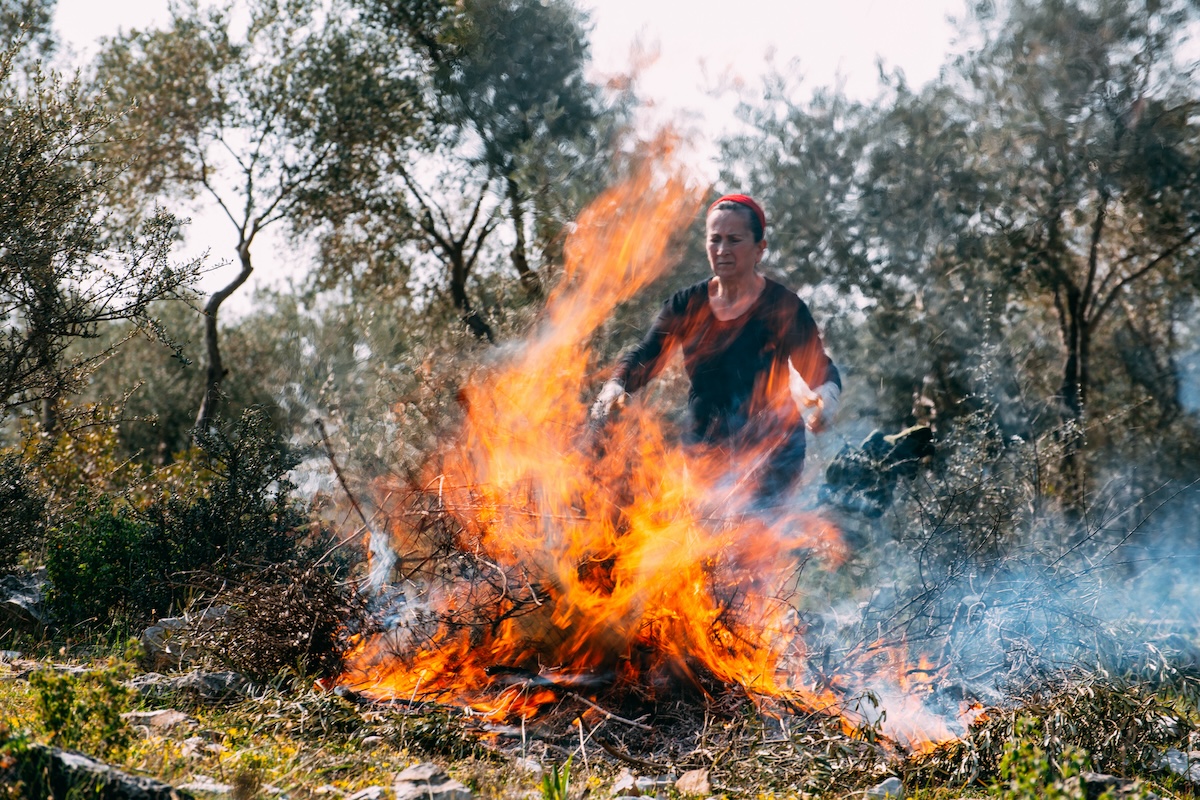
Leaf burning might seem like the most expedient way to clean up the fall lawn, but your local government might feel differently. According to the National Park Service, nearly 85 percent of wildland fires in the U.S. start because of humans, and burning debris like fallen leaves and trash ranks among the top human errors that cause wildfires. As a result, depending on where you live, leaf burning might be restricted or illegal. Burning leaves can also release a host of noxious chemicals that aren’t good for you or the environment.
1. It might be illegal.
Check the fire code for your municipality for any restrictions relevant to starting outdoor fires. Local governments usually distinguish between “closed burning,” which is confined to a structure such as a stove or chimney, and “open burning,” such as burning leaves in an exposed heap on the ground, which releases the fire byproducts directly into the atmosphere.
Many cities permit closed burning but ban open burning because open burning adds more to air pollution and can potentially result in an uncontainable fire. Areas that allow open leaf burning might require you to obtain a permit that authorizes fires of a limited size during certain months and at a designated location a specified distance away from dwellings.
Some local laws regarding backyard burning change according to season or take effect only when conditions are ripe for high pollution, wildfire risk, or public health issues. Before burning fallen leaves or any debris, even on a seemingly calm day, individuals should check to see whether any rules limiting smoke or fire are currently in effect.
2. It can be a hazard to your health and the environment.
Potential health impacts are perhaps the biggest reason not to burn leaves. Unlike burning natural gas in a furnace or even fuel in a car, processes that create mainly carbon dioxide and water as a byproduct, burning biomass sends a broader range of chemicals into the air, says Christopher Reddy, an environmental chemist with Woods Hole Oceanographic Institution who studies the negative impacts of burning natural and man-made products.
“When you burn leaves and other materials where you’re not having a very efficient burn, you are more likely to create a range of chemicals and particles that may cause harm to you and your family,” Reddy says. This particulate matter, naked to the human eye, poses the most risk to breathing.
“When you breathe these very small, fine-size particles, you could potentially have some detrimental effects to your body, particularly cardiovascular problems,” he says.
The smoke released by leaf burning can irritate your eyes, nose, and throat, and the carbon dioxide kicked up by burning leaves and remaining embers can, with enough exposure, reduce the amount of oxygen in your blood and lungs. This leads to coughing, wheezing, and other respiratory conditions that can sometimes persist.
Unsurprisingly, burning leaves also isn’t good for the environment. Although the federal government has no regulations affecting open burning, the Environmental Protection Agency (EPA) engages states and communities in studying the effects of open burning on the environment. Past studies by the agency have measured emission factors for burning leaves, such as particulates, carbon dioxide, and other harmful chemicals and gases released into the atmosphere. Many add to ground-level ozone (smog) that can damage sensitive ecosystems and negatively impact nearby crops and wildlife.
When You Shouldn’t Burn Leaves
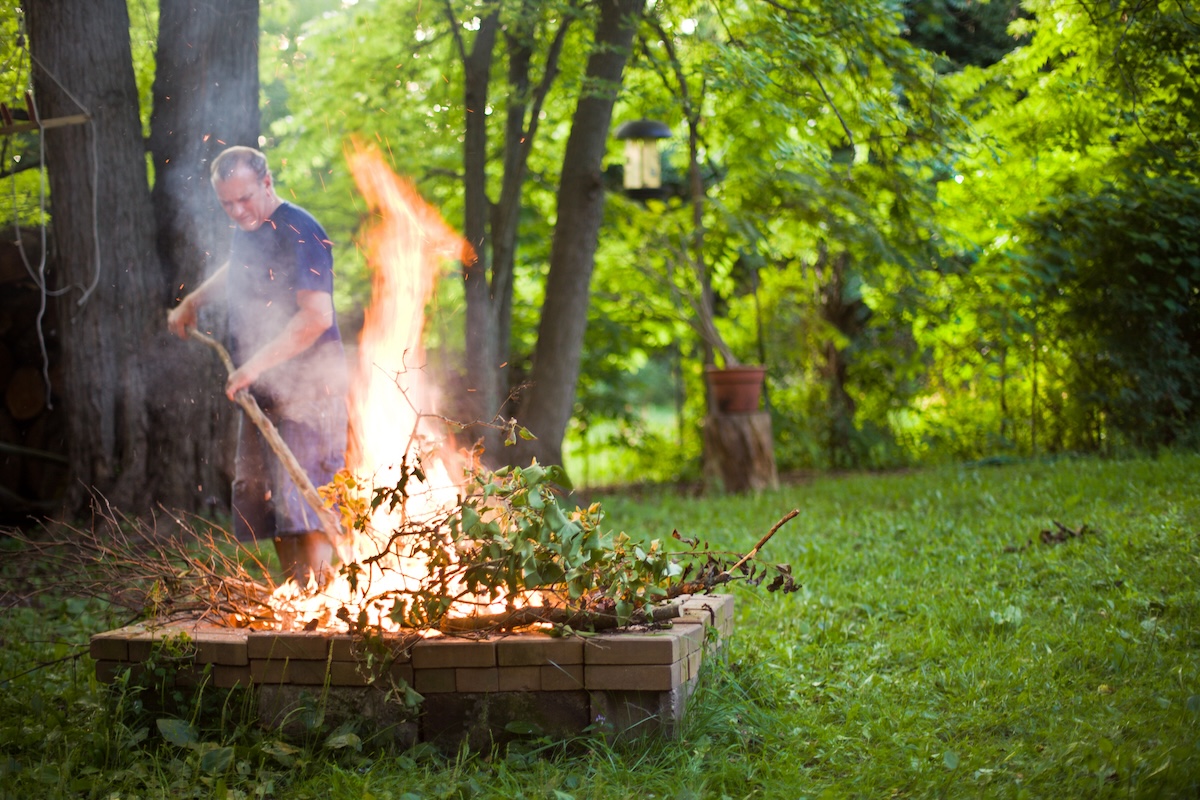
While we don’t recommend burning leaves, if you do need to do so, make sure you choose times when it’s safest. Pay attention to the weather and air quality, and don’t burn leaves during these conditions:
- During dry weather: When nearby grasses and wooded areas are dry because of a lack of rain, the chance of wildfires is elevated. Avoid burning leaves when the humidity has dropped below 20 percent or during extended periods without rain.
- When it’s windy: Never burn leaves when wind gusts exceed 25 mph, as burning leaves could be carried away by wind, creating a wildfire hazard and threatening nearby homes.
- Poor air quality: Don’t burn leaves when the Air Quality Index, which measures the level of air pollution, is Code Orange or higher; doing so will only add more pollutants to the air. In fact, many municipalities prohibit burning yard waste when the AQI is Code Orange or worse.
Alternatives to Burning Leaves

Given the many risks of burning leaves, it makes better sense to save the matches and lighter fluid for your charcoal grill and turn to safer and more environmentally conscious options. Disposing of leaves through mulching or composting is not only a more responsible approach but can also give your landscaping an assist. If you have no use for your leaves, many municipalities offer some type of leaf collection service.
1. Mulch the leaves.
Mulching leaves might sound like a lot of work, but it can be as simple as running a lawn mower over thin layers of dropped leaves. Once the leaves break down to pieces the size of a dime, leaving a thin layer of this mulch in place can benefit the lawn and many insects.
Just don’t leave a thick layer, especially of whole leaves. Matted leaves prevent air and sunlight from getting through. If you have lots of leaves, invest in a quality leaf mulcher; these are available as handheld tools, stand-alone mulchers, and special mower attachments.
2. Compost them.
Composting leaves can take a little more time, especially if you’d like to see the benefits of your work. If you already have a compost pile, add leaves as part of your balanced composting. Again, breaking leaves down into smaller pieces before adding them speeds up the composting process.
If you’re new to composting, you can start a pile of composting leaves in a bin or corner of your yard that gets plenty of sun and drainage. Add some nitrogen-rich matter like grass clippings or food waste to the top and build the pile up to about 3 feet high and 4 feet wide.
Turn the compost monthly to mix the ingredients, and wet it periodically during dry periods. Compost needs a little moisture to decompose. It’s ready to use when it appears dark, like soil, and crumbles.
3. Shred them.
Some wood chippers include shredding chutes that chop up leaves and other softer yard waste. When paired with wood chippers, these two-in-one tools function like leaf mulchers. It is not recommended to use a standard wood chipper chute for chipping leaves, though. Be sure the chipper has a designated shredding chute.
4. Collect them.
Even if you choose to mulch and compost some leaves, you can tackle the remaining leaf cleanup fairly easily with a rake and bags. Gather leaves soon after they fall, when they are less crumbly and have more nitrogen to give.
Choose a rake with an ergonomic handle to ease strain and a large tine spread for more efficient sweeps with the rake. A leaf blower can make quicker work of gathering leaves, but a gas-powered blower is not as sustainable as a good old garden rake and a little sweat.
If you’re happy with your city’s pickup and disposal system, bag the leaves and place them on the curb. Some cities offer monthly leaf or yard waste pickup days or collect on specific dates just in the fall. Check for those dates and to see if your town recycles yard waste into usable mulch for residents.
The easiest way to collect leaves is to rake them onto a tarp and then lift the edges up to “pour” the leaves into the bag. Find biodegradable plastic bags, sturdy paper bags designed for leaf collection, or reusable garden bags, if the local solid waste department allows their use.
How to Safely Burn Leaves
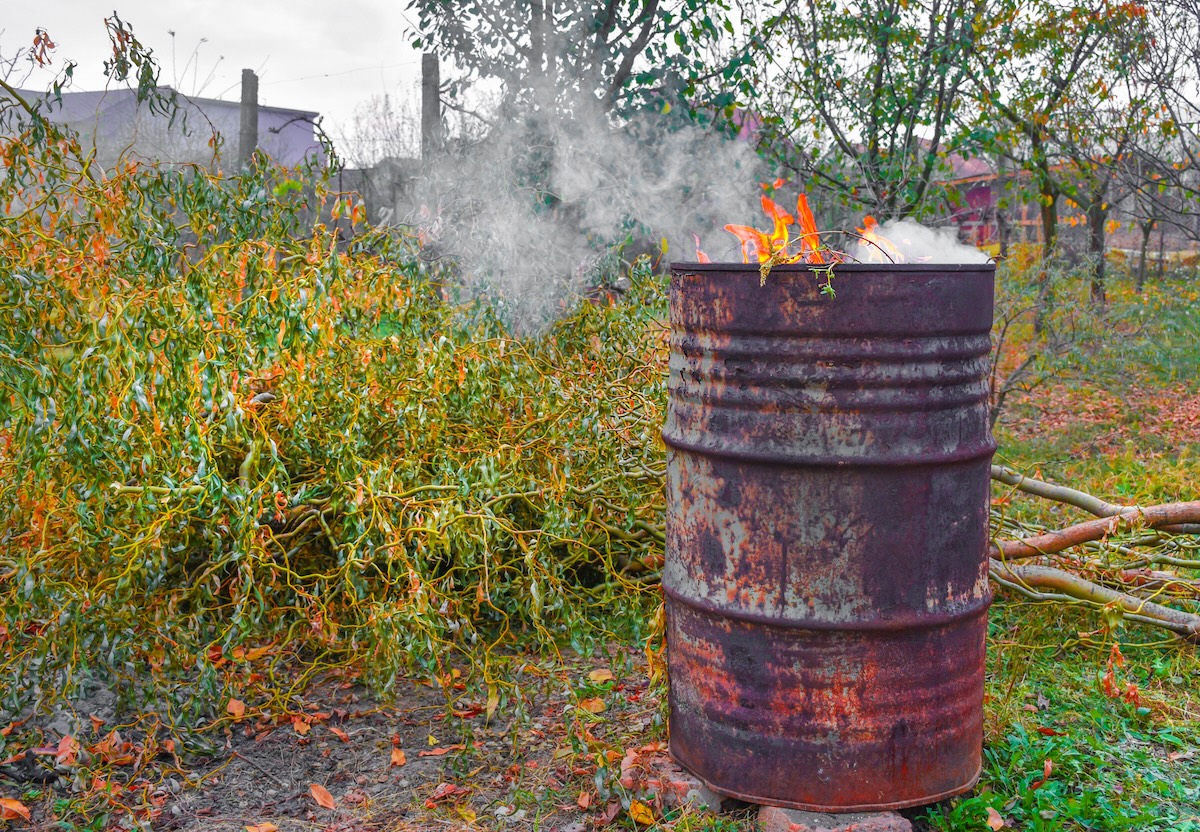
There are better options than leaf burning that don’t pose a threat to the environment or your health. However, if you decide to burn leaves, make sure to do so safely and follow local laws and regulations. Here are some tips for the best results.
1. Use a burn barrel.
The best way to burn leaves is with a burn barrel, a large metal container designed to dispose of combustible waste. It is a safer, more contained method for leaf burning than a pile. To use a burn barrel, fill it with leaves, top it with a lid or screen to minimize smoke and prevent burning debris from escaping, and then ignite it to efficiently and quickly incinerate the leaves.
You can make a burn barrel out of a heavy-duty 55-gallon metal drum. Be sure to punch at least 10 to 15 holes in the side of the drum. These holes should be about ½ inch in diameter, large enough to vent air but not so large as to let debris escape. Adding drain holes to the bottom of the barrel helps water run out when you douse the remains.
The safest bet, however, is to use a professionally designed all-metal burn barrel. Even when you’re using a barrel, always have a water source within reach before igniting your leaves.
2. Choose a proper burning site.
Most cities restrict burning yard waste to your own private property—so forget about setting the stuff aflame in a woodland, field, or other public space. Plan to burn fallen leaves on a vegetation-free, level patch of dirt located at least 50 feet from occupied dwellings; more distance is better.
Burn barrels are safer than open piles. If you choose to burn leaves in a pile, be sure it is no higher or wider than 4 feet. Aim for a minimum vertical clearance (unobstructed space above the fire free from tree branches, power lines, etc.) of at least three times the height of the leaf pile or barrel. Lay bricks or cinder blocks around the perimeter of the patch of leaves and clear an 8-foot to 10-foot-wide barrier of bare dirt around the patch to help contain flames.
Never use any type of fire starter or gasoline to begin leaf burning. This can lead to an unmanageable fire. These products also emit vapors that can cause an explosion in certain conditions.
3. Know what you can and can’t burn.
Municipalities that permit open burning generally allow the burning of leaves, tree branches, and general yard trimmings. (Of course, grilling or cooking is typically allowed as well.) That said, fire pits or campfires (or burn barrels, for that matter) should not be used to burn any materials coated with stain, paint, or glue.
Do not add any oils, rubber, or treated wood products to leaves when burning. Cities ban burning (and sometimes disposal of) paints, tires, household chemicals, and any petroleum products. Many also ban the burning of paper, cardboard, and general home garbage.
Burning synthetic materials such as rubber or plastic in with the leaves creates a much greater risk given the various additives they contain, Reddy says. “You need to be very careful about commingling,” he says. “You add a little plastic, and you’re creating a much more potentially harmful cloud of chemicals.”
4. Protect yourself.
Given the risks of burning leaves, it’s wise to take common sense precautions. Consider wearing an N95 mask or respirator, precautions the EPA suggests for reducing exposure to smoke and particles caused by wildfires. Reddy also recommends changing clothes before going back in the house after burning leaves to avoid bringing in any ash particles that have collected on your clothes.
Check With Local Authorities Before Burning Leaves
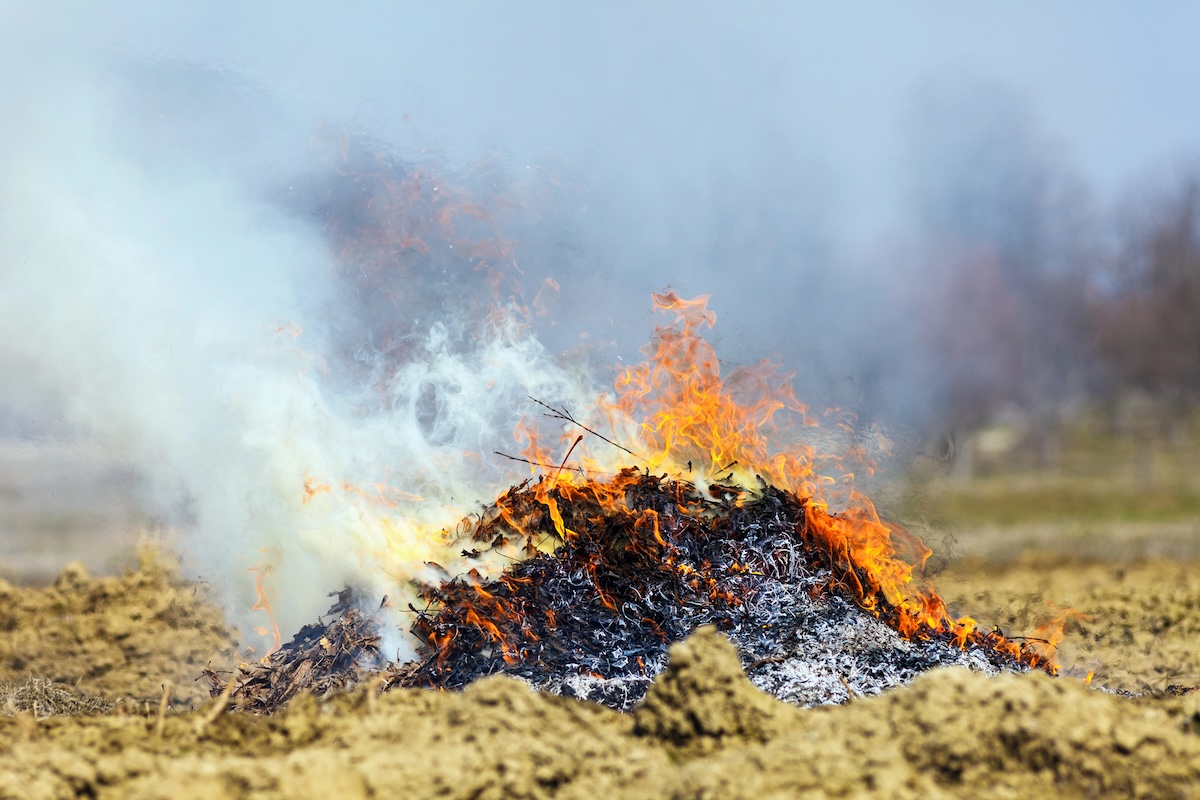
Despite what your city might allow you to burn, local conditions might restrict when you can burn leaves or other yard waste. Many limit the time of day you can start or add to a burn pile.
Further, cities might implement no-burn periods during times of drought and increased fire risk. Some laws also restrict burning when air pollution is especially bad. These periods typically fall in the summer months but can vary. Always check local ordinances before burning leaves or any waste. It is also a good idea to notify the local fire department of your plans in case a neighbor reports smoke.
Even if you live in a rural area without municipal rules regarding burning, the state might still have these types of regulations.
Final Thoughts
It’s never fun to clean that carpet of fallen leaves blanketing the yard, but burning leaves should be a last resort for cleanup. Consider alternatives like mulching or composting, and see what services your city offers to help dispose of leaves.If burning is your only alternative, learn how to burn leaves safely, and avoid adding to pollution or starting a wildfire.
